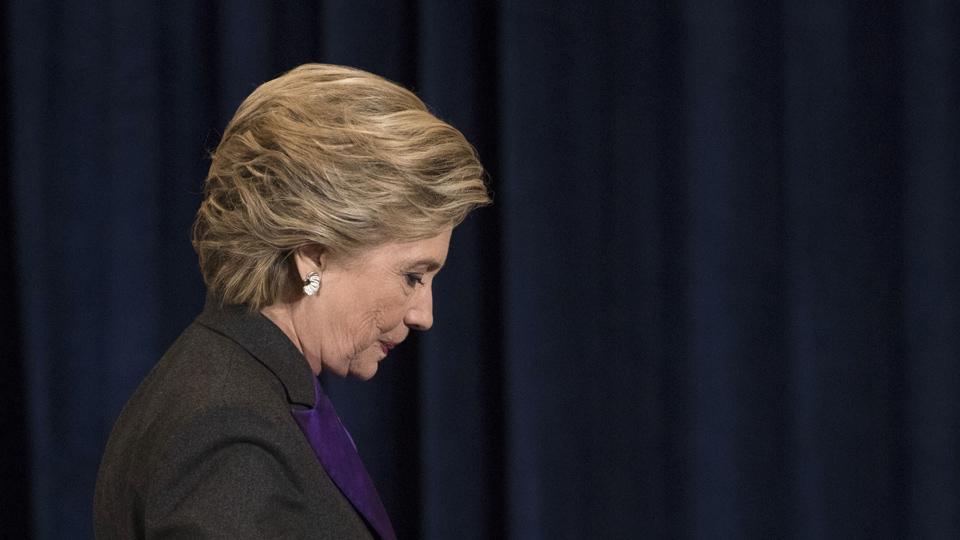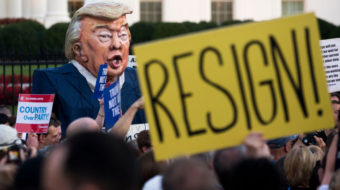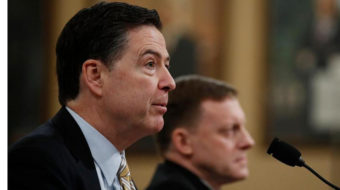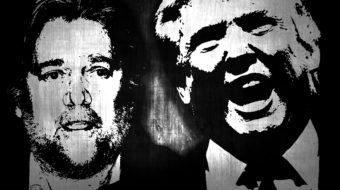
(This article is based on remarks delivered to the Communist Party USA National Committee, Nov. 19 in Chicago. It is the second of two parts; part one can be read here.)
However bitter this year’s election defeat, the broad electoral coalition that backed Hillary Clinton should not despair. Despite the unprecedented forces arrayed against her, she received the majority of votes. Trump did win 61.4 million votes though – a sobering indication of the extent of the mass right-wing Republican base.
Trump won 1.5 million more votes than Mitt Romney, indicating the right wing base has grown, but not substantially. However, the most extreme part of it has grown stronger, allowing white supremacists to take over the Republican Party apparatus.
Clinton received almost 65 million votes, nearly as many as President Obama in 2012. However, that’s still 4.5 million votes less than in 2008. And while Clinton assembled much the same coalition that twice carried Obama to victory, those voters turned out in lower percentages across the board.
And after voting for President Obama in 2008 and 2012, a section of white voters in Iowa, Wisconsin, Michigan, Ohio, and Pennsylvania shifted their support to Trump. How was it that Trump, a corrupt, selfish billionaire, who flies around in a private gold-plated jet, was able to portray himself as an anti-establishment outsider?
What happened?
For sure, the Clinton campaign and Democratic Party establishment bears their own measure of responsibility for this defeat, which I will discuss below. But I don’t think the argument Clinton was a “weak” candidate is convincing; there is more than an element of sexism in that statement.
Defeat cannot simply be laid at the doorstep of the Clinton campaign. It takes an electoral coalition to win an election in our two-party system, and the winning coalition is different in each election, even if just by degrees.
Take the 2008 election for example. The U.S. was in the midst of the biggest economic freefall since the Great Depression. Pres. George W. Bush was universally despised and blamed for the mess. Millions wanted change. They chose Obama, a once-in-a-lifetime candidate, over John McCain. Because many whites voted for Obama in 2008, some observers argue that it therefore can’t be true that these same voters were influenced by racism in 2016 when they changed course and voted for Trump.
But the situation in 2016 is different. Millions are fed up with politics as usual. They are angry at Wall Street, political institutions, and candidates associated with economic elites. Many saw Clinton as a representative of that world, but they gave the billionaire Trump a pass.
They are frustrated and cynical about gridlock, corruption, and corporate domination of government. Much of this so-called anti-establishment vote was influenced by the steady drumbeat of anti-government rhetoric and developed against the backdrop of the eight-year sabotage of the Obama administration by the extreme right in Congress.
Nevertheless, I don’t think this was primarily an economic populist revolt or a protest against political elites. If that were the case why did African Americans, the most sophisticated portion of the electorate, and Latino and Asian Americans overwhelmingly vote for Clinton? After all, communities of color are also experiencing great economic distress, compounded by racism.
Voters in these communities feel the same alienation to political elites, but they still voted for a Democratic Party establishment candidate connected to Wall Street to block a billionaire tycoon. While millions of whites stood with their black and brown sisters and brothers, some 58 percent voted for Trump. They voted against their own economic interests. Trump won a majority of every category of white voters.
The question is, why? We have to dig deeper into the larger economic, social, and political context.
Rooted in the brutal enslavement of millions of Africans and genocide against Indigenous peoples, racism has been a central thread throughout our nation’s history. It was instrumental in maintaining the slavocracy and after that, capitalist class power more generally. It has been used to extract super profits and to justify economic, social, and institutional inequality. It has been a central part of the story of growing right wing power over the past 60 years.
The “Southern Strategy” employed by Richard Nixon and later by Ronald Reagan succeeded as part of the backlash by reactionary forces to the vast social changes of the 1960s. The election of the nation’s first African American president was met by unprecedented obstruction by the GOP and reactionary sections of capital based on racism challenging his legitimacy as president. To this day, a large section of this right-wing base is so influenced by the racism of the “birther” movement led by Trump that they still believe Obama is not a U.S. citizen.
The demographic character of the U.S. is rapidly changing, with cultural and social mores shifting along with it. A new role for women and the LGBTQ community is emerging. All are shaping a new multi-racial, multi-national, multi-gender identity, multi-cultural, multi-lingual people and nation.
And these changes are taking place over the span of just a few decades. Since 1965, the immigrant population has grown from 9.6 million to 45 million, accounting for 55 percent of U.S. population growth. Between 1980 and 2008, the foreign-born Latino population grew four-fold from 4.2 million to 17.8 million.
These economic, demographic, cultural, and social changes (and the pace at which they are occurring) are unsettling to many whites. The backlash represented by a significant portion of the Trump vote is a reaction against the new multi-racial, multi-cultural society embodied in the Obama coalition.
In that sense, there are parallels with the Brexit vote. The tremendous social and economic stresses brought on by massive and rapid immigration on top of economic austerity and crisis were unsettling to millions.
The election has to be understood within the wider context of neoliberal capitalist globalization, which has brought massive social change and dislocation. Since the 1970s, unfair trade pacts, outsourcing, and automation have produced deindustrialization and left communities devastated. Death rates, suicides, and use of opiates are up. Economic stagnation, declining real wages, and a soaring wealth gap have left millions feeling left out, angry, and hopeless.
The same process of hollowing out industrial centers, creating highly segregated deep pockets of poverty in African American communities, is also causing deep poverty in rural areas and small industrial cities of segregated white communities. Many whites, particularly men, are among the victims of plant closings, wage cuts, home foreclosures, and economic dislocation – particularly in the Upper Midwest states.
Mass layoffs and plant and mine closings have heightened competition for jobs in the working class, sharpening racial anxieties and tensions, sexism, and xenophobia. Many whites feel their dignity and self-worth disappear as their economic status declines and the world and their place in it rapidly changes. They and their communities are up against powerful global economic forces they cannot fathom and feel helpless to fight.
When they are united with their class brothers and sisters in struggle, white workers experience the power of multi-racial, male-female class unity. They understand their advance is tied to expanding democracy for all. However, with deindustrialization also comes the destruction of the one organization that has united them with other communities – their union. They become ideologically disarmed and have no way to understand these changes from a working class perspective. Instead of multi-racial class unity, the void is filled with something else – racial identity politics.
For many whites, Trump taps into resentment against “distant elites” and speaks to their fear of a rapidly changing multi-cultural world along with new social mores and non-sectarianism. Through such appeals, a campaign based on white supremacy was able to win a majority of white voters. This helps explain also how, over the past few decades, as the white vote as a percentage of the electorate has decreased, white support for GOP candidates has increased. There has occurred a qualitative shift; the time was ripe for a white supremacist takeover of the GOP.
People are constantly being influenced by opposing ideas. They are often of multiple minds. Whites can simultaneously be influenced by both racist and anti-racist ideas. They respond to events depending on experience and their depth of consciousness. With higher levels of class, anti-racist, and anti-sexist consciousness, they can resist the poison of racism.
The same dynamic contributed to the lower level of resistance to voter suppression laws – which were especially aimed at disenfranchising African Americans, low-income workers, and youth. The result this year was an estimated 3 to 5 million disenfranchised voters.
These factors all show that it was not just class issues and economic populism that were at play in this election, but also broad democratic questions around gender, nationality and race. And incidentally, one can’t ignore how those issues played out in the Democratic Party primary either.
Bernie Sanders conducted a historic and unprecedented campaign, energized young and first time voters, and brought advanced ideas and socialism into the discussion. Certainly Sanders had a central role in shaping the Democratic Party platform.
But so did the Fight for $15, Black Lives Matter, the Dreamers, the climate justice movement, the LGBTQ community, and others who have helped shift mass public opinion over the past few years. And the deep support for
Clinton also shaped the platform including by advancing equal pay for equal work, criminal justice reform, etc. Her deep support among women, African Americans, and Latinos cannot be ignored. After all, she got 3 million more votes than Sanders.
What was needed coming out of the primaries was the broadest possible unity on the issues, keeping forces backing both candidates as united as possible for the general election battle.
Right-wing influence
The right-wing mass media, often uncontested, influences wide swaths of the country. Millions, including working people, get their news and opinion, much of it based on lies and conspiracy theories, from Fox News, hate talk radio, and white supremacist and hate groups. Those living in racially segregated communities, suburbs, small cities, and rural areas are especially vulnerable.
Breitbart “News,” the platform of the so-called alt-right, reaches millions. Such outlets acted as a free mass communications arm of the Trump campaign. There was also the deluge of false news and conspiracies spread by the right wing on social media. And of course the major cable TV networks cannot be forgotten; it is estimated Trump received over $2 billion in free coverage from them.
The Republican Party apparatus in the various states, the National Rifle Association, and the right-wing Christian fundamentalist churches all got out the vote for Trump. Right-wing religious institutions and networks, especially conservative evangelicals, have been a key part of the modern extreme right movement. Twenty-six percent of the electorate were Christian evangelical voters; 81 percent of white evangelicals voted for Trump, the highest vote for a Republican since 2004.
While Clinton’s unfavorable rating was 55 percent among voters overall, it was 80 percent among evangelicals. The key issue for evangelicals appears to have been abortion. For 21 percent of voters, abortion was a bottom line issue, up from 13 percent in 2008.
The payoff to these forces will be the appointment of a U.S. Supreme Court Justice who will vote to repeal Roe v. Wade, outlaw abortion, and perhaps undermine same-sex marriage by ensuring legal protections for religious conservatives to discriminate.
Pervasive misogyny
Hillary Clinton conducted a historic campaign. The election of the first woman president was a material force, a motivating and inspiring cause for millions. Had she won, it would have been an advance for democracy, as was the election of Barack Obama. As a public figure shaped by the turbulent 1960s, Clinton has been a leader of the movement to advance women’s rights. She embodies the rapidly changing status of women in society and, consequently, has been the object of every form of misogyny and hate.
Millions were inspired by her history-making campaign. Not surprisingly, she won by the highest gender margin ever, with women of color leading the way. Sexism and misogyny in their most blatant forms, however, were at the center of the election. They prevented millions from voting for the first woman president.
Influences of sexism on the left were also all too prevalent during the election and the primaries. Aside from the women’s equality movement, gender issues were too often downplayed or pitted against other concerns. The movements and society overall pay for these “sins of omission.” If we are to advance, the interconnections between class, race, and gender need to be deepened.
It’s really up to white people and especially white men – and furthermore, communists, socialists and those with broad awareness – to take the lead in reaching those who were misdirected and are under the sway of reactionary ideology.
Reviled by the right
During Bill Clinton’s administration, Hillary Clinton forged her own role, stood up to right-wing efforts to destroy her husband’s presidency, and became a political force in her own right. The extreme right never forgave her for it and she has been vilified ever since.
Republicans transformed her use of a private email server and unproven allegations of corruption in the Clinton Foundation into criminal acts in the public mind. Chants of “Lock her up!” dogged Clinton at every step. Days before the election, FBI director James Comey, at the behest of a right-wing gang within the Bureau, revived suspicions of criminality when he reopened the email investigation. The damage was done. Many voters, including suburban white women on the fence, decided to vote for Trump.
In addition to the FBI interference, the Clinton candidacy was also up against Julian Assange, working in unison with the Russian oligarchy and probably the Putin government. Wikileaks’ constant email dumps created chaos on the eve of the Democratic Party convention, kept Clinton on the defensive throughout the campaign, and cast a shadow implying that she was hiding something.
This kind of interference, especially by a foreign government, is unprecedented. The criminalization of Clinton overshadowed her program and allowed some voters to give in to false equivalencies. To them, she was no better than Trump. Many of these voters either sat out the election or voted third party.
Mistakes of the campaign
The Clinton campaign certainly made mistakes and had some built-in flaws. Clinton was the face of the Democratic Party corporate establishment, part of the political and economic power structure at a time of growing anti-corporate outrage.
She opposed the Trans-Pacific Partnership, but because of Pres. Obama’s support for it, her previous backing of the pact, and the free trade agreements negotiated by the Bill Clinton administration, she could not escape association with the TPP. Her paid speeches at Goldman Sachs gave further credence to the image of her being Wall Street’s candidate.
Clinton ran, however, on the most progressive platform of any major party in history. She addressed class, race, and gender issues, yet her economic message still didn’t resonate strongly with enough voters. The campaign too often chose to focus on the unfitness of Trump as commander-in-chief rather than on day-to-day economic concerns.
It did not effectively build on Bernie Sanders’ call to change the “rigged economic system.” His candidacy tapped into mass thinking, energized millions of voters, especially young people, and was instrumental in shaping the Democratic platform.
The Democratic Party and the campaign failed to reach out to large swaths of small towns, cities and rural areas that were largely populated by whites. It relied too much on demographic changes alone to win a progressive governing majority. The temptation to write off white communities and the fifty-state strategy was a fatal flaw.
The 2016 elections were a huge setback for social progress and pose an enormous danger to democracy and life on Earth. However, the defeat is rich in lessons upon which greater unity of our multi-racial, multi-gender identity, multi-generational working class and people can be forged. Without that, we will be powerless to block the coming assault on truth, social programs, basic democratic rights, peace, and the environment.












Comments